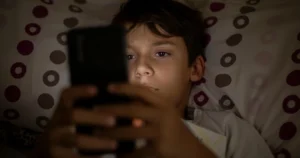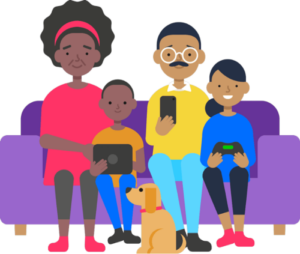During the summer holidays it can be difficult to pull your tweens and teens away from their smartphones or tablets. Whether it be chatting to their friends on social media or gaming online, the internet offers children a digital escape during the summer break.
Exploring the digital world together
Many parents worry about how to amuse their young ones during the school holidays, whilst many children are involved in summer camps or holiday clubs, stay at home parents and those who work flexible hours or from home often feel that the responsibility to keep children busy falls to them.
Particularly with older children and teens, the temptation (or pester power) to allow them to play on computers, or watch endless hours of YouTube can be overwhelming! Let’s get something straight, computer games and technology are not bad, but as with everything, moderation is key. Firstly, it is really important to ensure your child is safe online, are they playing age appropriate games, and if they are online, who are they talking too? But why not try something different this summer?
Getting active with apps
With the health and fitness of families in sharp focus, why not use this opportunity to spend time together, doing something active, online AND fun? There are some new gadgets and games that may just help.
Many of you will have heard of Pokémon Go, the biggest game of the year by far. Why not play as a family team? It encourages physical activity (you have to walk a certain distance to hatch eggs), strategy (set some lures to catch more Pokémon) and is appropriate for all ages. You get to see some beautiful places too!
Some of you may have Fitbit or other fitness measuring devices. Why not set the family a daily walking or swimming challenge?
Capturing memories online
Or if you’re going on holiday, why not start a family travel blog or vlog using Blogger or YouTube? The whole family can participate, get the kids to review the waterpark or entertainment, while the parents write about food and places visited? You can share it with friends and family and it would make a wonderful memento to look back on.
Balancing screen time with other activities
Children are spending more time online learning, socialising, playing games, creating and publishing in ways that we could not possibly have imagined when we were children ourselves.
Impact of the digital world
Much has been written about the impact that the digital world which, broadly speaking, is either quite negative and focuses on the risks children face online or is more positive and focuses on the educational, school related benefits for children online. But when is comes to the holidays parents often feel that they are being a ‘bad’ parent if they have let their children have too much ‘screen time’.
How is too much screen time?
A sensible balance of ‘screen time’ and other activities is important but this will vary from family to family and from child to child according to their individual needs, interests and family circumstances and whether it is unsupervised time alone or as a shared activity.
Recent research from the LSE has shown that is not about the quantity of ‘screen time’ that should be concerning parents but the quality of how that time is spent. Just as the summer holidays enable families to spend time exploring new places and doing new things together, rather than just imposing a set limit on how long children are online, good parenting is about talking to children, taking an interest in and understanding what they are doing online and sharing some of the online activities with them.
Making screen time count
Rather than being anti-social, lonely and isolating, screens can be social, connecting and creative. Playing games together, looking up new places to visit or finding out ‘what’s on’ in your area are great ways to share screen time in a positive way and making a digital scrapbook of holiday photographs, mementos and links to places visited means your family can also have a lovely record of the holidays to treasure.
Gaming on the Go – a close look at Pokémon Go
Pokémon Go is already being hailed as the “game of the summer”, with players of all ages getting out and about searching for “Pokémon”, creatures of all shapes and sizes, on their mobile phones.
Virtual reality meets the real world
It is part of an emerging generation of “augmented reality” apps, which allow players to look through the camera on their phone and see a game superimposed onto the world around them. In the case of Pokémon Go, the game overlays Pokémon over real locations for gamers to capture, collect, evolve and fight.
What are the risks?
As with any piece of social technology there are risks. However, I do not feel Pokémon Go introduces many new risks that we do not see in technologies such as social media.
Certainly given the outdoor nature of the game, there is a risk you might not be looking where you are going! There have already been stories of people wandering into traffic and getting lost. However, there is little difference between this and those engrossed in the messages on their mobiles while walking down the street.
Stranger danger
There are other, potentially more concerning, aspects of the game that do present risk for children. One of the fundamental aspects of gameplay is to meet with others, to interact with them, to “battle” them and to share information of Pokémon locations, which raises concerns around strangers approaching young people with offers of sharing locations of Pokémon, and similar.
Pokestops, places where Pokemon can be found, and Gyms, where trainers can battle each other, are real world locations and therefore there is a risk that those wishing to meet children might lurk around these locations. However, these are generally very public places and, given the number of players of the game, busy.
What you can do to keep kids safe
Mitigating against such risks falls back on common sense more than technical knowhow. One would hope we would not be happy with one of our children running off on their own all over a town, playing near main roads, or being free to speak to whomever they wish without parental supervision. There is nothing technological in the game that raises risk beyond what we might normally see around “stranger danger”, and setting boundaries around where children can play.
Additional costs of game
Another aspect of the game that can present some challenges is the potential for expensive in-app purchases. Players can purchase in game currency to buy items that improve their prospects in the game. This can be managed effectively by changing the settings to not allowed in game purchases, as, without such measures, it is possible to make some fairly sizable purchases (the most expensive single purchase is £79.99 for a considerable amount of “Pokecoins”).
Play together to make the most of the app
Nevertheless, what is the most important thing to remember is that the game is great fun and of course children and young people want to play it. Being aware of the potential pitfalls helps mitigate the potential harm that might arise but in essence the game presents little new in terms of risk to young people. And it also presents a great opportunity to have a conversation within families about the game.
For younger children it is an opportunity to play together and to incorporate playing the game into family outings. But even for older children, who would probably not want to be seen out looking for Pokémon with their mum, showing an interest in what they are doing and talking about how they play the game is going to result a far stronger understanding of the game.
Hidden cost of ‘freemium’ gaming apps
There are millions of apps that cover just about anything and everything you can imagine. Recipes for the kitchen? There’s an app for that. Information about local buses and trains? Currency exchange rates? Definitely. But where apps really excel is in respect of games. Which is where your children come in.
Is a free app really ‘free’?
The vast majority of apps are “free” to download, which is one of the reasons they are so instantly appealing to kids. But “free” rarely means exactly that. You often won’t pay at the point where you download the game but what your child might quickly discover is that in order to do anything really interesting or exciting with it they have to buy something, like a shield or a sword or maybe they need a new virtual pony to enter the gymkhana.
Here’s the catch. In order to have been able to download the “free” app in the first place your son or daughter will usually have to have entered a credit or debit card and likely as not that will be yours.
Cost of in-app purchases
Some parents have been horrified to discover that their children – literally – then spent thousands of pounds of their money and they only found out at the end of the following month when the credit card bill arrived or when the bank rang up to tell them they had or were about to exceed their overdraft limit.
So the key message is: when setting up an account to allow your children to download apps it’s really important to pay attention to the options you are provided with to restrain the amounts of money they can spend. You can either set a cash limit or require them to get permission from you every time. And if you are going to set a limit make sure they understand it’s part of their pocket money allowance not just an extra! Unless you’re made of money, but so few of us are.
Sharing summer selfies safely
When you hear the word holiday what does it conjour up for you? Six weeks of…Ice creams, sun cream, sunburn, floppy hats, sandals or paddling pools and beaches?
Holidays snaps on polaroid
Do you remember when you were young or your children (if they are older than about 15 years of age) and large or disposable cameras could be heard going click in the background taking pictures of these things and making memories?
Remember how those pictures would probably end up neatly stored in an album, or kept in the developers envelope? This meant you or your parents could decide when or who could/not see these holiday photos.
Selfie generation
If you consider in today’s world technology (smartphones) allows for pictures to be taken almost anywhere anytime and “selfies” are the most common type of picture taken with a smartphone. Apps like Snapchat and other ‘filter’ based selfie apps allow for instant sharing of those images.
Taking and sharing photos by young children in holiday outfits such as shorts/bikinis/swimming costumes and sexualised outfits for young girls can be difficult to manage WITHOUT talking to your child first. As apps develop the capacity to store these images for later sharing or distribution it becomes even more important to speak with your children about sharing these images.
How far can a digital image go?
Remember the photo album? Those photos get to stay there and only be seen by people when you choose. Photos uploaded and shared in cyberspace can (by accident on the child’s part) end up in the wrong hands and with the wrong type of people. Holiday selfies maybe belong in safe hands and not the Internet?
Dealing with online trolls
When I think of trolls I think of the three Billy Goats Gruff trip trapping across the bridge with the troll lurking in the depths underneath. It can feel like that with internet trolls – as if there are dark forces waiting to snap up our children.
What are online trolls?
The reality is that trolls are just people. If you’ve ever seen the MTV show Catfish you will know how small and wretched these trolls can be when confronted face to face by the person they’ve hurt. But the hurt is real – and it’s right that you follow your instinct to protect your child – wherever they are wandering.
Responding to trolling
So here are some things to keep in mind. This is not child’s play – it’s an adult world with adult dangers. The majority of your child’s experiences online are positive, but that doesn’t mean it doesn’t hurt when someone attacks. And the attack can come from friends or from strangers. Be ready with a hug. Look them in the eye and remind them that so much of what they see and read online is pure fantasy. They are wonderful and unique and definitely not a follower.
Arm your child with truth, love, common sense and a sense of humour – and the reassurance that together you can take on any army. Once that’s clear and you have a Katniss Everdeen on your hands, make sure they go out there, explore and have the time of
their lives.









